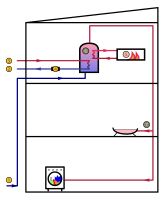
Photo from wikipedia
Abstract The flexibility of thermal energy systems can support the energy system as a whole in integrating a large share of fluctuating renewable energy sources. The current paper investigates the… Click to show full abstract
Abstract The flexibility of thermal energy systems can support the energy system as a whole in integrating a large share of fluctuating renewable energy sources. The current paper investigates the flexible operation potential of a small district with buildings connected to a district heating network. In the study, the thermal mass of the buildings was utilized as heat storage and the investigation was performed for the heating season. The load shifting scenarios used were created based on the available information on heat load and dynamic heat production cost in the Greater Copenhagen district heating system. The results of the study indicate that the applied strategy of load shifting is highly effective. The achieved load shifting in all schedule-based scenarios was between 41% and 51%. The applied scenarios resulted in an increased peak demand and energy use. However, the increased energy use occurs mostly during the low-load periods, when the heat production prices are lower. It was also shown, that the increased peak can be partially mitigated by using the appropriate control strategies.
Journal Title: Energy and Buildings
Year Published: 2020
Link to full text (if available)
Share on Social Media: Sign Up to like & get
recommendations!